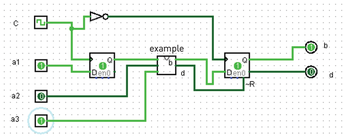Simulate digital circuits with Logisim
Multiplex Connection
In multiplex cinemas, people walk in at a common entrance and take a seat in the desired theater. An n-bit multiplexer works similarly. However, encoders, which simulate the end of a movie night, wherein visitors come out of the individual cinemas and leave the building from a common exit, need a closer look.
The design of a parallel 1-bit multiplexer (Figure 8) begins in the Combinational Analysis window. To start, create the appropriate truth table and then click Build Circuit. In the window that opens, select the NAND gate and assign a name to the circuit. A NAND operator corresponds to an inverted AND operator. NAND gates are considered universal, because any logical function can be implemented by this type alone.
To create a multiplexer manually, open the Plexers library and drag a Multiplexer onto the canvas. For a 2-bit multiplexer, you need two data lines and one control bit, which you set in the Select Bits and Data Bits drop-downs, respectively, in the attribute table (Figure 9). This combination gives you four inputs (00, 01, 10, 11) numbered 0 through 3, another input for the selector (control) pin, and one output. After connecting pins to the inputs of the multiplexer, set the control signal – found on the bottom side of the multiplexer – to 2 bits in the attribute window, and then add an LED for the output, which is found under Input/Output | LED.
 Figure 9: In this 2-bit multiplexer, the inputs are on the left side and the control pin is at the bottom. The output is an LED located to the right of the multiplexer.
Figure 9: In this 2-bit multiplexer, the inputs are on the left side and the control pin is at the bottom. The output is an LED located to the right of the multiplexer.
Divide and Conquer
When programming, you reuse code by creating functions (subroutines, methods), and you do the same thing in Logisim by creating subcircuits.
To create a timed circuit, you can integrate the aptitude test, which in this case represents the logic, between two D flip-flops. To start, create a new circuit by calling up the context menu of the project folder with a right-click, choose Add Circuit, and give it a name. Drag two flip-flops to the canvas.
To insert the example subcircuit between the two D flip-flops, click once on the name of the subcircuit in the tree structure on the left. The mouse pointer changes to a block that represents the subcircuit, which you now add to the canvas and connect to the flip-flops (Figure 10).
The D flip-flop has only one output, which also needs to go to an input on the subcircuit, so you need to add two more input pins to the subcircuit. The subcircuit has two outputs, one of which you connect to the input of the second D flip-flop. The other output goes to the reset input (~R) of the second D flip-flop.
Testing
The most beautiful circuit is of little use if it doesn't work, so you should test your circuit before using it. To test logical circuits such as this aptitude test, choose the Poke (pointing finger) tool in the menubar. By clicking an input pin several times, you can change its value and observe the behavior of the outputs. Logisim color highlights active lines (i.e., those through which data bits are currently flowing) during the simulation.
Logisim has a special feature for time-controlled circuits: The Simulate | Ticks Enabled menu item automatically starts ticking the clock, so you only have to change the data inputs to observe the circuit's behavior.
Logisim also offers an export function that creates a drawing of the circuit under File | Export Image. In the resulting window, you select the desired image format and scaling.
« Previous 1 2 3 Next »
Buy this article as PDF
(incl. VAT)
Buy Linux Magazine
Subscribe to our Linux Newsletters
Find Linux and Open Source Jobs
Subscribe to our ADMIN Newsletters
Support Our Work
Linux Magazine content is made possible with support from readers like you. Please consider contributing when you’ve found an article to be beneficial.

News
-
Canonical Releases Ubuntu 24.04
After a brief pause because of the XZ vulnerability, Ubuntu 24.04 is now available for install.
-
Linux Servers Targeted by Akira Ransomware
A group of bad actors who have already extorted $42 million have their sights set on the Linux platform.
-
TUXEDO Computers Unveils Linux Laptop Featuring AMD Ryzen CPU
This latest release is the first laptop to include the new CPU from Ryzen and Linux preinstalled.
-
XZ Gets the All-Clear
The back door xz vulnerability has been officially reverted for Fedora 40 and versions 38 and 39 were never affected.
-
Canonical Collaborates with Qualcomm on New Venture
This new joint effort is geared toward bringing Ubuntu and Ubuntu Core to Qualcomm-powered devices.
-
Kodi 21.0 Open-Source Entertainment Hub Released
After a year of development, the award-winning Kodi cross-platform, media center software is now available with many new additions and improvements.
-
Linux Usage Increases in Two Key Areas
If market share is your thing, you'll be happy to know that Linux is on the rise in two areas that, if they keep climbing, could have serious meaning for Linux's future.
-
Vulnerability Discovered in xz Libraries
An urgent alert for Fedora 40 has been posted and users should pay attention.
-
Canonical Bumps LTS Support to 12 years
If you're worried that your Ubuntu LTS release won't be supported long enough to last, Canonical has a surprise for you in the form of 12 years of security coverage.
-
Fedora 40 Beta Released Soon
With the official release of Fedora 40 coming in April, it's almost time to download the beta and see what's new.



